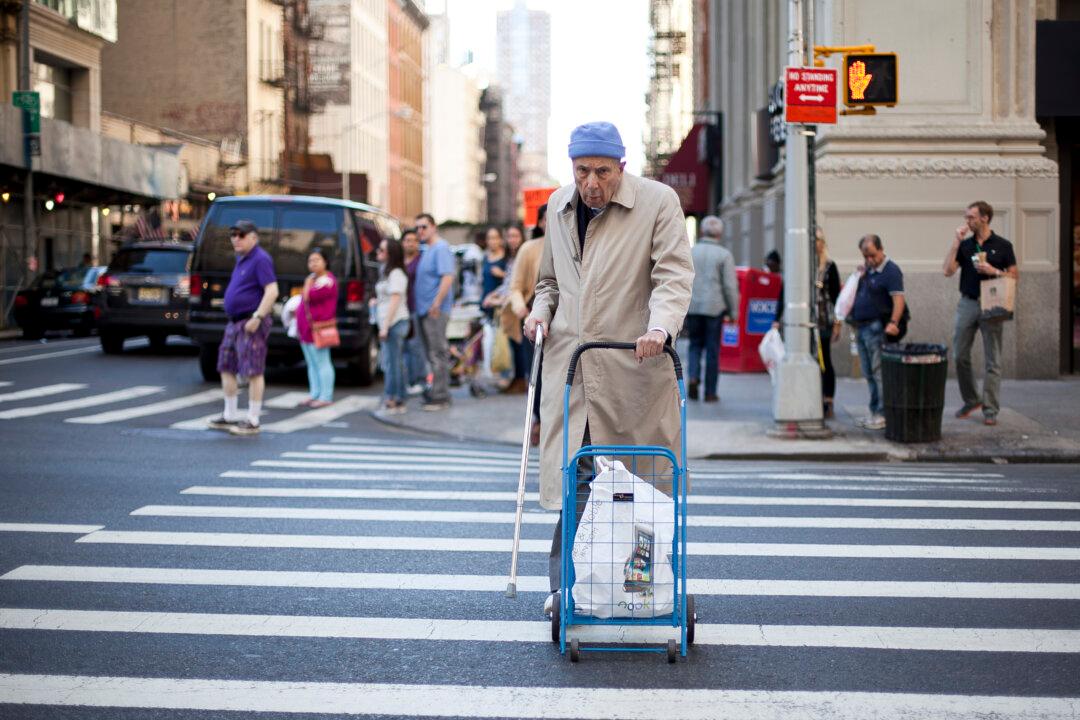NEW YORK—A tall gray-haired man looked across Amsterdam Avenue at West 74th Street as yellow cabs and trucks sped by. The “walk” signal illuminated. He set his cane on the road and began making his way across.
He was a strong man, with a body type telling of years of physical work. But the work, or maybe ailments that come with age, or turns of fate, nearly crippled him. In four seconds he traveled less than five feet.
Amsterdam Avenue is 60 feet across and the traffic signal holds the cars at the intersection for 40 seconds. At his pace, the man was still 10 feet away from the sidewalk by the time the cars began to accelerate toward him.
The traffic light turned green and the engines roared as the drivers pushed on the accelerators. The man quickened his pace.
This man’s dilemma raises some big questions. Can we design a city to accommodate those who are slower and more vulnerable?
Should he have known that he can’t make it across on time at his pace, even though the intersection is one of the most forgiving in the vicinity in terms of allotted crossing time? Does he have to stay home if the streets are too dangerous?
People who are 65 or older make up 12 percent of the city’s population, yet they account for 36 percent of all pedestrians killed by cars, according to a 2013 presentation from the Department of Transportation (DOT).
Gene Aronowitz, who watched the man from Josies Corner Cafe and Bake Shop on the other side of Amsterdam Avenue, knew the man would not make it across on time.
Aronowitz, 75, gave a class on street safety for the elderly at a residence for seniors nearby. At the end of his talk he offered seniors a speed test. He strung a 20-foot rope between two chairs and timed seniors as they walked the stretch. All but one made it on time. The gray-haired man was slower than that. (The seniors in this story are not identified by name at the request of the senior residence).
Two years ago, Aronowitz could barely walk. He made a lifestyle change and began to exercise daily and ride his bicycle. Today he walks with ease, but remembers the time when he couldn’t.
“I know how vulnerable you can be. That is why I do this,” Aronowitz said.
At the senior center he advised people not to cross the street immediately upon arriving at an intersection with a walk signal on. There is no way to predict how long the signal has been on, and it is safer to wait until the light cycles to the next walk phase. Aronowitz cautioned about bicyclists, cars that reverse and make U-turns, puddles, and other nuisances that could turn deadly.
“When he says the street is dangerous I agree. I’ve become very frightened. The drivers are aggressive. They immediately start when the light changes. They don’t wait,” said a 72-year-old female resident who uses a walker. She clocked one of the fastest times on Aronowitz’s speed test.
People nodded as Aronowitz went on. When it came to speed tests, he said the results were not exact, because everyone became a little competitive.
“Come on. We’ve got to catch the boat when we go to the cruise on Thursday,” Pat Brown, the activities director at the senior residence, said.
In 2008, the DOT identified 25 locations with the highest rates of senior pedestrian injuries and fatalities and targeted them for improvements. The department has since added safety features like countdown timers, pedestrian islands, and sidewalk extensions. Senior pedestrian fatalities decreased from an average of 62 per year between 2000 and 2007 to 50 per year since 2008 when the department began implementing the changes.
But Aronowitz believes that’s not enough. He looks forward to a time when the number of fatalities and injuries is zero. He conducts his senior safety classes under the umbrella of Transportation Alternatives, a nonprofit advocating bike lanes, alternative forms of transportation, and safety features throughout the city.
Two years ago, when Aronowitz began to ride a bicycle, he wrote to his council member in Brooklyn asking for a bike lane in the neighborhood. That step turned into a two-year campaign that finally brought a bike lane to Fifth Avenue in Brooklyn. He has become more involved since then. He visited some 10 senior centers in the past year and a half.
“I think that they are all feeling unsafe. In fact if you don’t feel unsafe, you’re delusional,” Aronowitz said.
As the cars rushed toward him, the gray-haired man walked off the crosswalk and found safety behind a police barrier left in the last lane of Broadway.
“If I can only save a single life,” Aronowitz said leaning back in his chair at Josies. “It would be worthwhile.”
http://www.nyc.gov/html/dot/downloads/pdf/safestreetsforseniors.pdf
10 Street Safety Tips for Older People
1. When shopping, consider using a cart. It will help with balance. Don’t carry too many items at once. Instead make multiple trips or request delivery.
2. Avoid wearing headphones or using a cellphone.
3. At night, wear bright clothing, cross in well-lit areas, and consider carrying a flashlight.
4. Follow pedestrian signals, but still look before crossing.
5. If the pedestrian signal does not have a countdown, wait until the next “walk” signal before crossing.
6. When crossing look left, right, and then left again and continue looking while crossing. Watch out for bicycles—they may be going in the wrong direction.
7. Get eye contact with the drivers closest to you.
8. Be on the lookout for turning or reversing vehicles.
9. Use crosswalks to cross streets. Sometimes the lines are very light or missing—use the corner to cross anyway.
10. If you are still in the crosswalk by the time the light changes, raise your hand to gain the driver’s attention.
(Courtesy of Gene Aronowitz)





